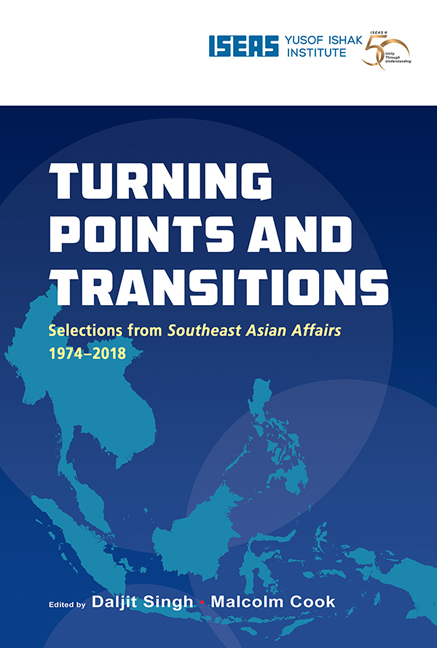Book contents
- Frontmatter
- Contents
- Message from the Director
- Foreword
- Foreword
- Introduction
- THE REGION
- The Diplomatic Emergence of China and Its Implications for Southeast Asia (1975*)
- Stability and Security in the Region after ANZUK (1975)
- The Question of the “Overseas Chinese” (1976)
- Southeast Asia 1976: The Handling of Contradictions (1977)
- The “Fukuda Doctrine” and Its Implications for Southeast Asia (1978)
- Expanding Horizons in Southeast Asia? (1994)
- AFTA in the Light of New Economic Developments (1995)
- The ASEAN Economic Miracle Unravels (1999)
- Southeast Asia in 1999: A False Dawn? (2000)
- East Timor's Future: Southeast Asian or South Pacific? (2001)
- Southeast Asia in 2002: From Bali to Iraq — Co-operating for Security (2003)
- The Year in ASEAN: The Charter, Trade Agreements, and the Global Economic Crisis (2010)
- Seeking Stability in Turbulent Times: Southeast Asia's New Normal? (2015)
- China's Two Silk Roads Initiative: What It Means for Southeast Asia (2015)
- China's International Strategy and Its Implications for Southeast Asia (2016)
- BRUNEI
- CAMBODIA
- INDONESIA
- LAOS
- MALAYSIA
- MYANMAR
- THE PHILIPPINES
- SINGAPORE
- THAILAND
- VIETNAM
East Timor's Future: Southeast Asian or South Pacific? (2001)
from THE REGION
Published online by Cambridge University Press: 29 May 2019
- Frontmatter
- Contents
- Message from the Director
- Foreword
- Foreword
- Introduction
- THE REGION
- The Diplomatic Emergence of China and Its Implications for Southeast Asia (1975*)
- Stability and Security in the Region after ANZUK (1975)
- The Question of the “Overseas Chinese” (1976)
- Southeast Asia 1976: The Handling of Contradictions (1977)
- The “Fukuda Doctrine” and Its Implications for Southeast Asia (1978)
- Expanding Horizons in Southeast Asia? (1994)
- AFTA in the Light of New Economic Developments (1995)
- The ASEAN Economic Miracle Unravels (1999)
- Southeast Asia in 1999: A False Dawn? (2000)
- East Timor's Future: Southeast Asian or South Pacific? (2001)
- Southeast Asia in 2002: From Bali to Iraq — Co-operating for Security (2003)
- The Year in ASEAN: The Charter, Trade Agreements, and the Global Economic Crisis (2010)
- Seeking Stability in Turbulent Times: Southeast Asia's New Normal? (2015)
- China's Two Silk Roads Initiative: What It Means for Southeast Asia (2015)
- China's International Strategy and Its Implications for Southeast Asia (2016)
- BRUNEI
- CAMBODIA
- INDONESIA
- LAOS
- MALAYSIA
- MYANMAR
- THE PHILIPPINES
- SINGAPORE
- THAILAND
- VIETNAM
Summary
Introduction
Following on from the tragic events of September 1999, East Timor will shortly become the world's newest nation. Presumably, in time it will also become a member of the Association of Southeast Asian Nations (ASEAN). As it charts its way forward, one of the key challenges it faces will be to define its international economic orientation. Indonesia and Australia will always be East Timor's major trading partners and diplomatic focus, in addition to its membership of the Portuguese-speaking world.
However, there is a broader question of whether its world-view, and its political, economic and social institutions, will be predominantly “Southeast Asian” or “South Pacific”. This is meant not simply in a geographic sense, since a case could be made for the fact that it belongs to either region. Nor is it addressing the issue of whether an independent East Timor will join both ASEAN and the Pacific Islands Forum (or whether it might even be forced to choose between them). Rather, it is the more fundamental question of whether its economic performance will more closely resemble that of its neighbours to its northwest or east. That is, will it be an outward-looking, growing and increasingly prosperous country, or a mendicant, aiddependent state, with a bloated public sector and stagnant living standards. The latter, unfortunately, characterizes many of the Pacific Islands.
In many respects, after the immediate task of rehabilitation is completed, East Timor will resemble a typical Pacific Island economy, albeit at the poorest end of the spectrum. It will be a large aid recipient, dependent also on remittances. Its institutions are weak, and its human capital resources rather limited. It is small, both in a geographic and a demographic sense, and rather isolated.
With its history of neglect and oppression, it is difficult to be optimistic about the future. The challenges might appear insuperable. Much of its physical infrastructure is shattered, while the supply of public utilities is most inadequate.
More than 80,000 of its people are still located in squalid refugee camps across the border in West Timor, and in other parts of Indonesia. It does not possess a constitution, a political system, or a functioning bureaucracy.
- Type
- Chapter
- Information
- Turning Points and TransitionsSelections from Southeast Asian Affairs 1974-2018, pp. 101 - 111Publisher: ISEAS–Yusof Ishak InstitutePrint publication year: 2018



